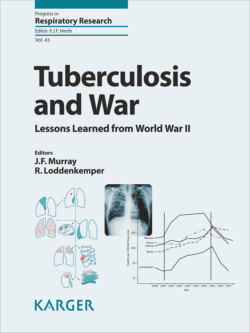Читать книгу Tuberculosis and War - Группа авторов - Страница 28
На сайте Литреса книга снята с продажи.
Biological Warfare
ОглавлениеBiological warfare is defined as the use of both infectious agents, such as bacteria, viruses, and fungi, and/or biotoxins, with the intent to kill people, or more inclusively living organisms. The earliest practice of biological warfare, as far as is known, is documented in Hittite records of 1500–1200 BCE [84]. The strategy was simple. Victims of tularemia, presumably including Hitittes themselves, were driven into enemy territory to spread an epidemic of deadly disease. In the Trojan War, both arrow and spear tips were coated with poison; a later refinement of Scythian archers (4th century BCE), introduced tipping of arrows and spears with snake venom, blood, or feces to increase the likelihood of infection. Another early tactic was to hurl clay pots filled with poisonous snakes or scorpions on enemy ships or troops. Corpses of bubonic plague victims have long been used as weapons. Genghis Kahn catapulted dead bodies of infected Mongol warriors to break the siege of Kaffa (Crimea), after which the defending Tartar forces retreated and the Mongols took over the city in 1346.
After more and more European settlers arrived in North America, the broadening association with Native Americans was inevitable, so was the spread of highly contagious smallpox, measles, and other infections to extremely vulnerable, immunologically naïve domestic inhabitants. Fatality rates were enormous. Spontaneously developed smallpox in the 18th century, especially, was a major cause of indigenous American depopulation; plus, there may have been instances of deliberate spread by British forces of contaminated blankets to transmit disease to Native Americans [85].
Little biological warfare occurred during WWI, chiefly by Germans who spread infectious anthrax and glanders. In 1925, the Geneva Protocol outlawed biological weapons, but research, production, and storage were unaffected. During WWII, the Japanese undertook a large-scale program to develop and use biological weapons, which engaged over 5,000 workers and “killed as many as 600 prisoners a year in human experiments” in but a single of its 26 study sites [86]. Widespread testing of pathogenic organisms on prisoners occurred, and on at least one occasion, more than 1,000 water wells were poisoned by the Japanese army in their effort to investigate outbreaks of cholera and typhus in Chinese villages. A few of the epidemics that were launched by the Japanese during the war persisted for several years after the conflict. During the Holocaust, Nazi doctors experimented on Jewish prisoners in various concentration and extermination camps [87]. These experiments often took the form of injecting prisoners with typhus as part of research projects aimed at developing a vaccine. If victims did not die during the experiments, they were killed with injections of phenol into their hearts. Because Jews were targeted for annihilation by their Nazi captors, these typhus experiments were a specific kind of biological warfare.
Beginning in 1949, the US explored the mock warfare value of experiments, studying the spread of bacterial aerosols in over 200 different sites. The author was involved in one such test in September 1950 – along with 800,000 other San Francisco Bay guinea pigs – who were exposed to a “harmless” (i.e., non-infectious) bacterial aerosol: instead of deadly anthrax [88]. In 1969, most Americans breathed easier after President Nixon terminated the weapons program, and in 1972, he signed the Biological and Toxin Weapons Convention agreement. Despite this interdiction, in 1973 the Soviet Union began operating a gigantic biological warfare research project called Biopreparat, employing over 50,000 people in several centers. Naturally, there were casualties. In the early 1970s, 3 of ten people infected with smallpox died in a Soviet biological warfare accident, and in 1979 a large outbreak of anthrax occurred following a mishap in another bioweapons factory; in this instance 66 people and numerous animals died [89]. Biological warfare research still goes on, but deeply clandestine and illegal, and poses a major threat to the US from ISIS (Islamic State of Iraq and Syria) and other terrorist groups.
